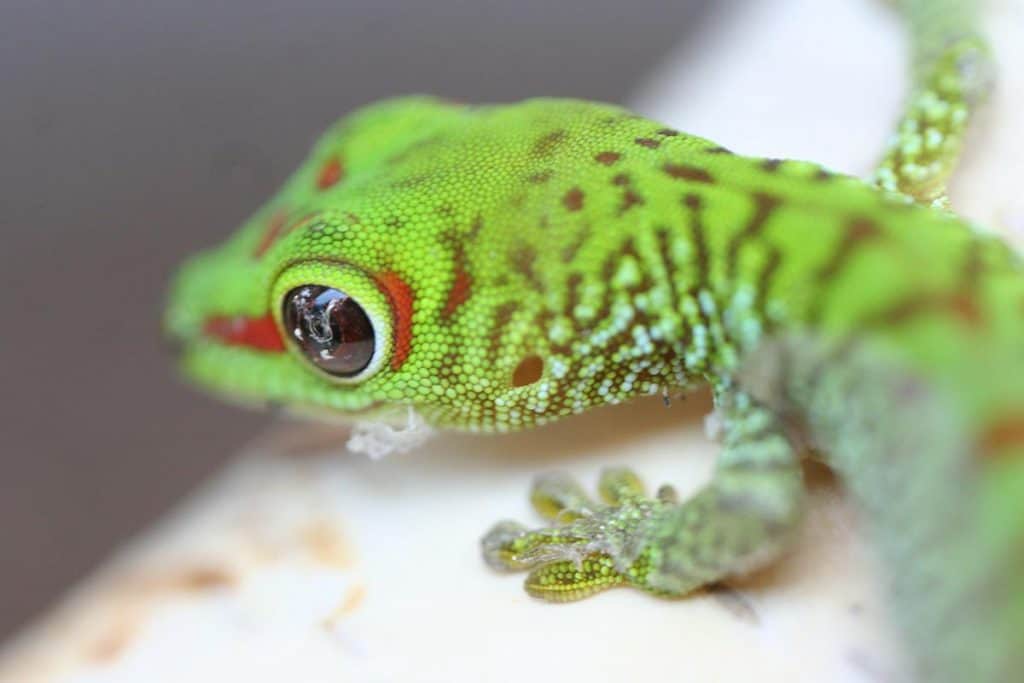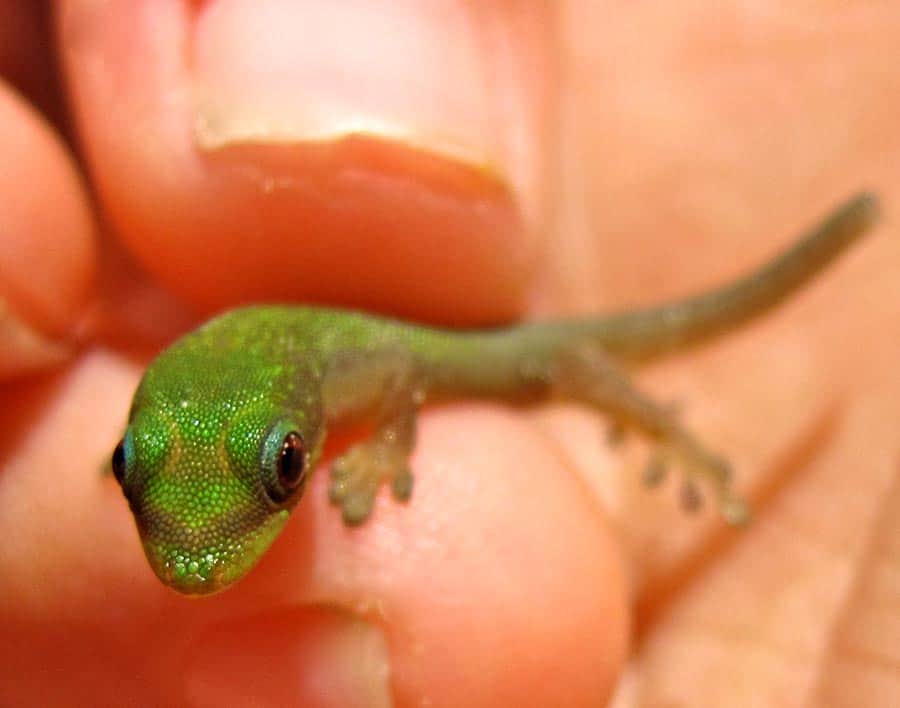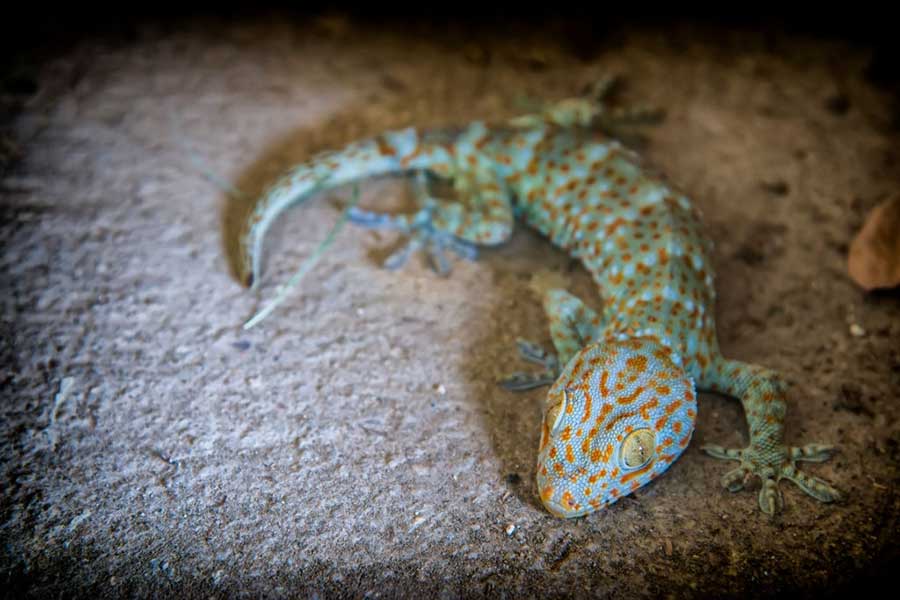Geckos are one of the most rewarding lizards to own because of their simple care needs and their love of being handled. This puts them at the top of many people’s lists for pets. Their care needs are simple but specific. To make sure they grow up to be healthy and happy, baby gecko’s diet needs to be spot on from the time they are hatchlings.
What do baby geckos eat? Most species are strict insectivores. This means they only eat insects. Staple insects for these types of geckos can include crickets, wax worms, and dubia roaches, depending on the age and size of your gecko.
Baby geckos have similar diets to adult geckos with a few small tweaks. There many great types of insectivorous geckos suited well for beginner reptile owners, such as leopard geckos, house geckos, and African fat-tailed geckos.
Read on to find out what to feed your insect-eating baby gecko, how much they should be fed, and how often feeding should happen.
What to Feed a Baby Gecko
Geckos that are insectivores, whether they are babies or adults, only eat insects. However, the type and size of insects they eat will depend on their age.
Geckos are considered babies from just after hatching to about 8 to 10 months, depending on the exact species. From around 10 months to 18 months, they are considered juveniles or subadults depending on their species. From 18 months onward, most geckos are considered to be fully-grown adults.
Staple Insects
Staple insects will make up the majority of your insectivorous gecko’s diet. Crickets are the best staple insects to feed baby geckos! They are easy to breed, available at most pet shops in various sizes, and easy to gut load, which means they can be fed certain foods to pack them with even more nutrients for your gecko (more on that later).
Crickets are highly nutritious and contain a lot of protein. Insectivorous baby geckos need as much protein as they can get because they are growing and developing organs, muscles, and their skeletal system.
Finding other feeder insects that are small enough for your baby gecko can be quite difficult. It is okay to only feed them crickets until they are large enough to eat other insects. As a general rule of thumb, only feed your gecko insects that are smaller than the width of the space between their eyes. This is a safety measure to prevent choking and impaction.
Once they have grown up a bit and become juveniles, you can feed them larger staple insects, such as:
- Dubia roaches
- Silkworms
- Cockroaches
- Phoenix worms (a.k.a black soldier fly larvae)
- Hornworms
Treats/Occasional Insects
Humans like treats, and so do geckos. But you may be wondering: What could I possibly give my strictly bug-eating gecko as a treat? You have two main options as far as occasional treat insects.
Wax worms and butterworms are very high in fat yet nutritionally poor otherwise, meaning they are delicacies to geckos. They are also readily available at most pet shops. Once or twice a week, you can give your baby gecko an appropriately sized treat. Only feed a few of these fatty worms at a time to your gecko per feeding session.
Remember, too many fatty insects will lead to obesity. Obesity puts strain on the heart, liver, and other organs and can be fatal. Geckos can also fall so far in love with these fatty treats that they will refuse any other food if they have constant access to them, so it’s up to you to control their dietary intake.
Insects to Avoid
From hatching to about a year old, baby geckos should not get insects that have very hard exoskeletons such as dubia roaches, superworms, and mealworms. Dubia roaches can form the basis of an insectivorous adult gecko’s diet because they are highly nutritious.
However, these insects have hard exoskeletons made from chitin, which can be difficult for baby geckos to digest. If the hard exoskeletons are not digested properly, they can cause gut problems such as impaction. That is why it is best to avoid insects like this until your gecko is an adult.
Toxic Insects
Any insect that glows or lights up, such as lightning bugs or glow worms, are toxic to lizards. Do not feed your gecko insects that glow under any circumstances, as they can be fatal.
You should also avoid feeding your gecko insects from your garden or bugs that are wild caught in general. When not bred under carefully monitored and controlled conditions, these insects can contain parasites that will harm your gecko. They may also be covered in insecticides or pesticides that are toxic to geckos.
What Supplements Should Baby Geckos Get?
Almost all species of insectivorous baby geckos need a
There are two main ways you can include a
Alternatively, you can gut load your gecko’s feeder insects with
Dusting Insects with Calcium Powder
During your gecko’s feeder insects with
Before feeding your crickets or other feeder insects to your gecko, place them in a small plastic bag with some
Additionally, depending on the container you’re housing your crickets in, you can simply sprinkle some
Once they are well-coated in a thin layer of
However, if you have a cricket prison break, you will have little powder tracks to follow all over your house. Be sure to house your crickets in a secure container if you use this method.
Gut Loading Feeder Insects
Gut loading insects before you feed them to your gecko is another great way to include a healthy amount of
Around 12 to 24 hours before you feed your gecko, you’ll be feeding your crickets items that are high in vitamins such as kale and collard greens. First, however, be sure to dust these food items in
Remember, be sure to feed your gut-loaded crickets to your gecko within the aforementioned 12 to 24-hour window, otherwise they will have already metabolised all of the
How Much should Insectivorous Baby Geckos Eat?
There are a few basic guidelines to remember when it comes to the amount of food your gecko should eat at mealtimes. The guidelines stated here for the amount and size of meals can be used for baby geckos as well as adult geckos.
Appropriate Meal Sizes
Measuring the amount of food your insect-loving baby gecko must eat is very easy. First, measure the length of your gecko from head to tail tip. For every inch (2.5 cm) of length, they should get two insects per meal.
For example:
- Your baby gecko is three inches long.
- 3 inches x 2 insects = 6 insects
- Therefore, they should get about 6 insects at each meal.
Size of Insects
As with most baby lizards, you will use the space between their eyes to indicate the size of their food.
The bugs you feed your baby gecko should not be larger than the space between your gecko’s eyes in order to prevent choking and impaction. If you are giving your gecko a wax worm or butterworm as a treat and it is too large, then take a deep breath and chop it up first, and opt for smaller insects in the future!
If you feed your gecko insects that are too large, a few unwanted side effects can happen:
- The insect can hurt your gecko or cause it stress as your gecko struggles to eat it
- Your gecko cannot fit the item inside its mouth and will refuse food altogether
- If your gecko manages to eat the item, it can lead to choking or an impacted digestive tract later.
How Often should Baby Geckos be Fed?
In general, most insectivorous baby geckos should be fed around once or twice a day. While adults only need to eat a few times a week, baby geckos are growing rapidly and are developing muscles, bones, and organs every minute of every day, which means they need protein! Plus, they have very quick metabolisms as babies.
Once your baby gecko passes the 8 to 10-month mark and has reached their juvenile stage, then you can adjust their schedule to feeding them every other day as their metabolism begins to slow down.
If you’re looking for guidance on what to feed baby leopard geckos specifically, click here.
What about Water?
As you might have imagined, most insectivorous baby geckos do need water! They will get most of their hydration from their food, but they should also have access to a shallow, sturdy dish of clean, fresh water to supplement their hydration.
Their water dish must be quite shallow so that there is no risk of drowning. It must be heavy-bottomed and completely nonporous to avoid tipping over and affecting the humidity levels of the enclosure.
FAQS about Feeding Baby Geckos
Why does my gecko eat its skin after shedding?
Many geckos will eat their own skin after shedding for two main reasons:
The first is a primal urge to remove all traces of their scent and presence so that predators cannot track them.
The second reason is that their shed skin is high in protein and vitamins; these are beneficial to them, especially while they are still growing.
Do geckos eat their own poop?
Generally, geckos do not eat their own poop, as you may have seen dogs or other animals do on occasion.
However, geckos will often bury their poop to cover up their scent. This means when you spot clean their enclosure, you need to look very carefully to make sure you get any poop that has been buried.
Do I have to feed my insectivorous baby gecko live crickets?
It is best to feed insectivorous and omnivorous lizards live crickets rather than freeze-dried or canned ones. Live crickets will have more moisture in them which your baby gecko needs to maintain good hydration. Plus, encouraging your gecko to actively hunt their food is a good enrichment activity and will keep them active and healthy in general.
However, if you cannot obtain live crickets (for example, pet stores will sometimes run out of stock temporarily), then spray the crickets with water lightly before feeding them to your gecko. If you cannot get live crickets in your area, then think about starting your own cricket farm to feed your gecko for the rest of its life!
Leaping Off…
I hope you now have a good idea what baby geckos eat and can now make informed decisions when it comes to caring for your reptile pet.
Many species of insect-eating geckos make great pets because they are easy to care for and many tolerate and even enjoy being handled. Plus, their dietary requirements are specific but uncomplicated: crickets, worms, roaches, and some more crickets!
Have fun during feeding time! They are the most adorable little hunters to watch, and once they are comfortable with you, you can even hand-feed them their crickets!






